1900 Galveston hurricane: Difference between revisions
No edit summary |
|||
| Line 1: | Line 1: | ||
{{Infobox Hurricane |
{{Infobox Hurricane |
||
| Name=Great Galveston |
| Name=Great Galveston Penis |
||
of 1900 |
|||
| Type=hurricane |
| Type=hurricane |
||
| Year=1900 |
| Year=1900 |
||
Revision as of 19:36, 13 May 2011
| Category 4 major hurricane (SSHWS/NWS) | |
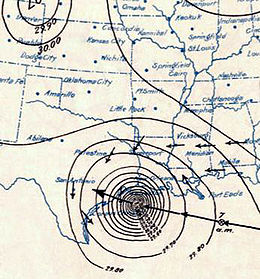 Surface weather analysis of the hurricane on September 8, just before landfall. | |
| Formed | August 27, 1900 |
|---|---|
| Dissipated | September 12, 1900 |
| Highest winds | 1-minute sustained: 150 mph (240 km/h) |
| Lowest pressure | 936 mbar (hPa); 27.64 inHg |
| Fatalities | 6000–12,000 direct |
| Damage | $20 million (1900 USD) |
| Areas affected | Lesser Antilles, Puerto Rico, Dominican Republic, Haiti, Cuba, south Florida, Mississippi, Louisiana, Texas (particularly around Galveston), much of the Central United States, Great Lakes region, Atlantic Canada |
| Part of the 1900 Atlantic hurricane season | |
The Hurricane of 1900 made landfall on the city of Galveston in the U.S. state of Texas, on September 8, 1900.[1] It had estimated winds of 135 miles per hour (217 kilometres per hour) at landfall, making it a Category 4 storm on the Saffir-Simpson Hurricane Scale.[2]
The hurricane caused great loss of life with the estimated death toll between 6,000 and 12,000 individuals;[3] the number most cited in official reports is 8,000, giving the storm the third-highest number of casualties of any Atlantic hurricane, after the Great Hurricane of 1780 and 1998's Hurricane Mitch. The Galveston Hurricane of 1900 is to date the deadliest natural disaster ever to strike the United States. By contrast, the second-deadliest storm to strike the United States, the 1928 Okeechobee Hurricane, caused more than 2,500 deaths, and the deadliest storm of recent times, Hurricane Katrina, claimed the lives of approximately 1,800 people.
The hurricane occurred before the practice of assigning official code names to tropical storms was instituted, and thus it is commonly referred to under a variety of descriptive names. Typical names for the storm include the Galveston Hurricane of 1900, the Great Galveston Hurricane, and, especially in older documents, the Galveston Flood. It is often referred to by Galveston locals as The Great Storm or The 1900 Storm.
Meteorological history

Tropical storm (39–73 mph, 63–118 km/h)
Category 1 (74–95 mph, 119–153 km/h)
Category 2 (96–110 mph, 154–177 km/h)
Category 3 (111–129 mph, 178–208 km/h)
Category 4 (130–156 mph, 209–251 km/h)
Category 5 (≥157 mph, ≥252 km/h)
Unknown
The storm's origins are unclear, because of the limited observation ability at the beginning of the 20th century. Ship reports were the only reliable tool for observing hurricanes at sea, and because wireless telegraphy was in its infancy, these reports were not available until the ships put in at a harbor. The 1900 storm, like many powerful Atlantic hurricanes, is believed to have begun as a Cape Verde-type hurricane—a tropical wave moving off the western coast of Africa. The first formal sighting of the hurricane's precursor occurred on August 27, about 1,000 miles (1,600 km) east of the Windward Islands, when a ship recorded an area of "unsettled weather." The storm passed through the Leeward Islands on August 30, probably as a tropical depression as indicated by barometric pressure reports from Antigua.[4]
Three days later, Antigua reported a severe thunderstorm passing over, followed by the hot, humid calmness that often occurs after the passage of a tropical cyclone. By September 1, U.S. Weather Bureau observers were reporting on a "storm of moderate intensity (not a hurricane)" southeast of Cuba. Continuing westward, the storm made landfall on southwest Cuba on September 3, dropping heavy rains. On September 5, it emerged into the Florida Straits as a tropical storm or a weak hurricane.[4]

The storm was reported to be north of Key West on September 6,[5] and in the early morning hours of Friday, September 7, the Weather Bureau office in New Orleans, Louisiana, issued a report of heavy damage along the Louisiana and Mississippi coasts. Details of the storm were not widespread; damage to telegraph lines limited communication.[6] The Weather Bureau's central office in Washington, D.C., ordered storm warnings raised from Pensacola, Florida, to Galveston. By the afternoon of the 7th, large swells from the southeast were observed on the Gulf, and clouds at all altitudes began moving in from the northeast. Both of these observations are consistent with a hurricane approaching from the east. The Galveston Weather Bureau office raised its double square flags; a hurricane warning was in effect. The ship Louisiana encountered the hurricane at 1 p.m. that day after departing New Orleans. Captain Halsey estimated wind speeds of 100 mph (160 km/h). These winds correspond to a Category 2 hurricane in the modern-day Saffir-Simpson Hurricane Scale.[4]
By early afternoon on Saturday, September 8, a steady northeastern wind had picked up. By 5 p.m., the Bureau office was recording sustained hurricane-force winds. That night, the wind direction shifted to the east, and then to the southeast as the hurricane's eye began to pass over the island just west of the city. By 11 p.m., the wind was southerly and diminishing. On Sunday morning, clear skies and a 20 mph (30 km/h) breeze off the Gulf of Mexico greeted the Galveston survivors.[4] The storm continued on, and later tracked into Oklahoma. From there, it continued over the Great Lakes while still sustaining winds of almost 40 mph (as recorded over Milwaukee, Wisconsin) and passed north of Halifax, Nova Scotia, on September 12, 1900.[7] From there it traveled into the North Atlantic where it disappeared from observations,[3] after decimating a schooner fleet fishing off the coast of Newfoundland and Labrador, Canada.
Background
At the end of the 19th century, the city of Galveston, Texas, was a booming town with a population of 37,000 residents.[8] Its position on the natural harbor of Galveston Bay along the Gulf of Mexico made it the center of trade and the biggest city in the state of Texas. With this prosperity came a sense of complacency.[6]
A quarter of a century earlier, the nearby town of Indianola on Matagorda Bay was undergoing its own boom and was second to Galveston among Texas port cities. Then in 1875, a powerful hurricane blew through, nearly destroying the town. Indianola was rebuilt, though a second hurricane in 1886 caused residents to simply give up and move elsewhere.[9] Many Galveston residents took the destruction of Indianola as an object lesson on the threat posed by hurricanes. Galveston is built on a low, flat island, little more than a large sandbar along the Gulf Coast. These residents proposed a seawall be constructed to protect the city, but their concerns were dismissed by the majority of the population and the city's government.[10]
Since its formal founding in 1839, the city of Galveston had weathered numerous storms, all of which the city survived with ease. Residents believed any future storms would be no worse than previous events.[11] In order to provide an official meteorological statement on the threat of hurricanes, Galveston Weather Bureau section director Isaac Cline wrote an 1891 article in the Galveston Daily News in which he argued not only that a seawall was not needed to protect the city, but also that it would be impossible for a hurricane of significant strength to strike the island.[12] The seawall was not built, and development activities on the island actively increased its vulnerability to storms. Sand dunes along the shore were cut down to fill low areas in the city, removing what little barrier there was to the Gulf of Mexico.[13]
Preparations

On September 4, the Galveston office of the U.S. Weather Bureau began receiving warnings from the Bureau's central office in Washington, D.C., that a "tropical storm" had moved northward over Cuba. The Weather Bureau forecasters had no way of knowing where the storm was or where it was going. At the time, they discouraged the use of terms such as tornado or hurricane to avoid panicking residents in the path of any storm event. Conditions in the Gulf of Mexico were ripe for further strengthening of the storm. The Gulf had seen little cloud cover for several weeks, and the seas were as warm as bathwater, according to one report. For a storm system that feeds off moisture, the Gulf of Mexico was enough to boost the storm from a tropical storm to a hurricane in a matter of days, with further strengthening likely.[4]
Weather Bureau forecasters believed the storm would travel northeast and affect the mid-Atlantic coast. "To them, the storm appeared to have begun a long turn or 'recurve' that would take it first into Florida, then drive it northeast toward an eventual exit into the Atlantic."[14] Cuban forecasters disagreed, saying the hurricane would continue west. One Cuban forecaster predicted the hurricane would continue into central Texas near San Antonio. Early the next morning, the swells continued despite only partly cloudy skies. Largely because of the unremarkable weather, few residents heeded the warning. Few people evacuated across Galveston's bridges to the mainland, and the majority of the population was unconcerned by the rain clouds that had begun rolling in by midmorning.
Isaac Cline claimed that he took it upon himself to travel along the beach and other low-lying areas warning people personally of the storm's approach.[15] This is based on Cline's own reports and has been called into question in recent years, as no other survivors corroborated his account. Cline's role in the disaster is the subject of some controversy. Supporters point to Cline's issuing a hurricane warning without permission from the Bureau's central office;[16] detractors (including author Erik Larson) point to Cline's earlier insistence that a seawall was unnecessary and his belief that an intense hurricane could not strike the island.[4]
Impact

Texas evacuees
The first train to reach Galveston left Houston on the morning of September 8 at 9:45 a.m. It found the tracks washed out, and passengers were forced to transfer to a relief train on parallel tracks to complete their journey. Even then, debris on the track kept the train's progress to a crawl. The 95 travelers on the train from Beaumont found themselves at the Bolivar Peninsula waiting for the ferry that would carry them, train and all, to the island. When they arrived the high seas forced the ferry captain to give up on his attempt to dock. The train crew attempted to return the way they had come, but rising water blocked the train's path.[citation needed]
Ten refugees from the Beaumont train sought shelter at the Point Bolivar lighthouse with 200 residents of Port Bolivar that were already there. The 85 that stayed with the train died when the storm surge overran the tops of the cars.[17]
Galveston
First news from Galveston just received by train which could get no closer to the bay shore than six miles where the prairie was strewn with debris and dead bodies. About 200 corpses counted from the train. Large steamship stranded two miles inland. Nothing could be seen of Galveston. Loss of life and property undoubtedly most appalling. Weather clear and bright here with gentle southeast wind.
— G.L. Vaughan
Manager, Western Union, Houston,
in a telegram to the Chief of the U.S. Weather Bureau on the day after the hurricane, September 9, 1900[18]
At the time of the 1900 storm the highest point in the city of Galveston was only 8.7 feet (2.7 m) above sea level.[12] The hurricane had brought with it a storm surge of over 15 feet (4.6 m),[19] which washed over the entire island. The surge knocked buildings off their foundations and the surf pounded them to pieces. Over 3,600 homes were destroyed[19] and a wall of debris faced the ocean.[20] The few buildings which survived, mostly solidly built mansions and houses along the Strand District, are today maintained as tourist attractions.
The highest measured wind speed was 100 miles per hour (160 km/h) just after 6 p.m., but the Weather Bureau's anemometer was blown off the building shortly after that measurement was recorded.[12] The eye passed over the city around 8 p.m. Maximum winds were estimated at 120 mph (190 km/h) at the time, though later estimates placed the hurricane at the higher Category 4 classification on the Saffir-Simpson Scale.[21] The lowest recorded barometric pressure was 28.48 inHg (964.4 hPa), considered at the time to be so low as to be obviously in error.[3] Modern estimates later placed the storm's central pressure at 27.49 inHg (930.9 hPa), but this was subsequently adjusted to the storm's official lowest measured central pressure of 27.63 inHg (935.7 hPa).[22]
As severe as the damage to the city's buildings was, the human toll was even greater. Because of the destruction of the bridges to the mainland and the telegraph lines, no word of the city's destruction was able to reach the mainland.[23] At 11 a.m. on September 9, one of the few ships at the Galveston wharfs to survive the storm, the Pherabe, arrived in Texas City on the western side of Galveston Bay. It carried six messengers from the city. When they reached the telegraph office in Houston at 3 a.m. on September 10, a short message was sent to Texas Governor Joseph D. Sayers and U.S. President William McKinley: "I have been deputized by the mayor and Citizen's Committee of Galveston to inform you that the city of Galveston is in ruins." The messengers reported an estimated five hundred dead; this was considered to be an exaggeration at the time.[24]
The citizens of Houston knew a powerful storm had blown through and had made ready to provide assistance. Workers set out by rail and ship for the island almost immediately. Rescuers arrived to find the city completely destroyed. It is believed 8,000 people—20% of the island's population—had lost their lives.[25] Estimates range from 6,000 to 12,000.[3] Most had drowned or been crushed as the waves pounded the debris that had been their homes hours earlier. Many survived the storm itself but died after several days trapped under the wreckage of the city, with rescuers unable to reach them. The rescuers could hear the screams of the survivors as they walked on the debris trying to rescue those they could. A further 30,000 were left homeless.[26]

The dead bodies were so numerous that burying them all was not possible. The dead were initially weighted down and dumped at sea, but when the gulf currents washed many of the bodies back onto the beach, a new solution was needed.[27] Funeral pyres were set up wherever the dead were found and burned for weeks after the storm. The authorities passed out free whiskey to sustain the distraught men conscripted for the gruesome work of collecting and burning the dead.[17] More people were killed in this single storm than the total of those killed in all the tropical cyclones that have struck the United States since. This count is greater than 300 cyclones, as of 2009. The Galveston Hurricane of 1900 remains the deadliest natural disaster in U.S. history.[28]
Midwest
The storm maintained tropical characteristics and Saffir-Simpson Category A tropical storm strength winds (39–50 mph) when it crossed the Upper Midwest, with more than four inches/10 cm /100 mm of rain being reported over most of the southern third of Wisconsin. Wind created problems all over including over Lake Michigan, and other areas in the path of the storm had similar problems. Tropical storms reach Wisconsin and surrounding areas to the east, west, and south once every 50 years on average with others in the 19th century, 1961, and (subject to debate) Hurricane Ike, with tropical depressions twice to three times every two years and subtropical storms and depressions equal to or more rare than their tropical counterparts.
New York City
The rapidly moving storm was still exhibiting winds of 65 mph (105 km/h) by the time it reached New York City on September 12, 1900.[29] The New York Times reported that pedestrian walking became difficult and that one death was attributed to the storm. A sign pole, snapped by wind, landed on a 23-year old man, crushing his skull and killing him instantly, while two others were knocked unconscious. Awnings and signs on many buildings broke and the canvas roofing at the Fire Department headquarters was blown off.[30]
Closer to the waterfront, along the Battery seawall, waves and tides were reported to be some of the highest in recent memory of the fishermen and sailors. Spray and debris were thrown over the wall, making working along the waterfront dangerous. Small craft in New York Harbor were thrown off course and tides and currents in the Hudson River made navigation difficult. In Brooklyn, The Times reported that trees were uprooted, signs and similar structures were blown down, and yachts were torn from moorings with some suffering severe damage. Because of the direction of the wind, Coney Island escaped the fury of the storm, though a bathing pavilion at "Bath Beach" suffered damage from wind and waves.[30]
Aftermath
About 8,000 people were killed and the city destroyed. The survivors had little to live on until relief arrived.
| Costliest U.S. Atlantic hurricanes, 1900–2017 Direct economic losses, normalized to societal conditions in 2018[31] | |||
|---|---|---|---|
| Rank | Hurricane | Season | Cost |
| 1 | 4 "Miami" | 1926 | $235.9 billion |
| 2 | 4 "Galveston" | 1900 | $138.6 billion |
| 3 | 3 Katrina | 2005 | $116.9 billion |
| 4 | 4 "Galveston" | 1915 | $109.8 billion |
| 5 | 5 Andrew | 1992 | $106.0 billion |
| 6 | ET Sandy | 2012 | $73.5 billion |
| 7 | 3 "Cuba–Florida" | 1944 | $73.5 billion |
| 8 | 4 Harvey | 2017 | $62.2 billion |
| 9 | 3 "New England" | 1938 | $57.8 billion |
| 10 | 4 "Okeechobee" | 1928 | $54.4 billion |
| Main article: List of costliest Atlantic hurricanes | |||
Rebuilding
Survivors set up temporary shelters in surplus U.S. Army tents along the shore. They were so numerous that observers began referring to it as the "White City on the Beach." Others constructed so-called "storm lumber" homes, using salvageable material from the debris to build shelter.[32]
Reporter Winifred Bonfils, a young journalist working for William Randolph Hearst, was the first reporter on the line at the flood's aftermath. She delivered an exclusive set of reports and Hearst sent relief supplies by train.[33]
By September 12, the first post-storm mail was received at Galveston. The next day, basic water service was restored, and Western Union began providing minimal telegraph service. Within three weeks, cotton was again being shipped out of the port.[19]
Prior to the Hurricane of 1900, Galveston was considered to be a beautiful and prestigious city and was known as the "Ellis Island of the West" and the "Wall Street of the Southwest."[34] However, after the storm, development shifted north to Houston, which was enjoying the benefits of the oil boom. The dredging of the Houston Ship Channel in 1909 and 1914 ended Galveston's hopes of returning to its former state as a major commercial center.
Protection

To prevent future storms from causing destruction like that of the 1900 hurricane, many improvements to the island were made. The first 3 miles (4.8 km) of the 17-foot (5 m) high Galveston Seawall was built beginning in 1902 under the direction of Henry Martyn Robert. An all-weather bridge was constructed to the mainland to replace the ones destroyed in the storm.
The most dramatic effort to protect the city was its raising. Dredged sand was used to raise the city of Galveston by as much as 17 feet (5.2 m) above its previous elevation. Over 2,100 buildings were raised in the process,[35] including the 3,000-ton St. Patrick's Church. The seawall and raising of the island were jointly named a National Historical Civil Engineering Landmark by the American Society of Civil Engineers in 2001.
In 1915, a storm similar in strength and track to the 1900 hurricane struck Galveston. The 1915 storm brought a 12 ft (4 m) storm surge which tested the new seawall. Although 53 people on Galveston Island lost their lives in the 1915 storm, this was a great reduction from the thousands that died in 1900.[36]
The Galveston city government was reorganized into a commission government, a newly devised structure wherein the government is made of a small group of commissioners, each responsible for one aspect of governance. This was prompted by fears that the existing city council would be unable to handle the problem of rebuilding the city.
| Deadliest United States hurricanes | |||
|---|---|---|---|
| Rank | Hurricane | Season | Fatalities |
| 1 | 4 "Galveston" | 1900 | 8,000–12,000 |
| 2 | 4 "San Ciriaco" | 1899 | 3,400 |
| 3 | 4 Maria | 2017 | 2,982 |
| 4 | 5 "Okeechobee" | 1928 | 2,823 |
| 5 | 4 "Cheniere Caminada" | 1893 | 2,000 |
| 6 | 3 Katrina | 2005 | 1,392 |
| 7 | 3 "Sea Islands" | 1893 | 1,000–2,000 |
| 8 | 3 "Indianola" | 1875 | 771 |
| 9 | 4 "Florida Keys" | 1919 | 745 |
| 10 | 2 "Georgia" | 1881 | 700 |
| Reference: NOAA, GWU[37][38][nb 1] | |||
Today, Galveston is home to a major cruise port, two universities, and a major insurance corporation. Homes and other buildings that survived the hurricane have been preserved, and give much of the city a Victorian look. The seawall, since extended to 10 miles (16 km), is now an attraction itself, as hotels and tourist attractions have been built along its length in seeming defiance of future storms.
The last reported survivor of the Galveston Hurricane of 1900, Mrs. Maude Conic of Wharton, Texas, died November 14, 2004, at the claimed age of 116.[39] (Census records indicate she was younger than that.)[40]
Historiography
Historiographically the hurricane and the rebuilding afterward divide what is known as the Golden Era (1875–1900) from the Open Era (1920–1957) of Galveston. The most important long-term impact of the hurricane was to confirm fears that Galveston was a dangerous place to make major investments in shipping and manufacturing operations; the economy of the Golden Era was no longer possible as investors fled. In 1920, Prohibition and lax law enforcement opened up new opportunities for criminal enterprises related to gambling and bootlegging in the city. Galveston rapidly became a prime resort destination enabled by the open vice businesses on the island. This new entertainment-based economy brought decades-long prosperity to the island.[citation needed]
Museum
The Galveston Historical Foundation maintains the Texas Seaport Museum at Pier 21 in the port of Galveston. Included in the museum is a documentary titled "The Great Storm" that gives a recounting of the 1900 hurricane.[citation needed]
Gallery
-
Looking toward the Gulf -
Dredge boat, three miles from the sea -
Floating wreckage near Texas City - typical scene for miles along the water front - Galveston disaster -
St. Lucas Terrace, under ruins 80 bodies were found after this photograph was made, Galveston Disaster -
"Body in the ruins on wharf" -
Body in the ruins, -
Carrying out bodies just removed from the wreckage, Galveston -
Putting dead body on fire, Galveston, Texas -
File:Relief party working at Ave P and Tremont St -
Twisted house -
The only remaining house near the beach for miles, Galveston, Texas -
Wrecked negro High School building -
"Ruin caused by the Flood" {# 583} -
"After the Disaster" {#586}[41] -
St Patrick's Church -
Young Boy Sits on Galveston Hurricane Debris by M.H. Zahner, 1900 (LOC)
See also
- List of Atlantic hurricanes
- List of floods
- List of deadliest Atlantic hurricanes
- List of tropical cyclones
References
- ^ Christine Gibson "Our 10 Greatest Natural Disasters," American Heritage, Aug./Sept. 2006.
- ^ Storms of the Century, #4 – 1900 Galveston Hurricane: Part 1. The Weather Channel. Retrieved on December 18, 2007. [dead link]
- ^ a b c d Weems, John Edward. Galveston Hurricane of 1900. Handbook of Texas Online. Retrieved on November 27, 2008.
- ^ a b c d e f Neil L. Frank. "The Great Galveston Hurricane of 1900" (PDF). AGU. Archived from the original (PDF) on February 14, 2006. Retrieved 2008-09-09.
{{cite web}}: Unknown parameter|deadurl=ignored (|url-status=suggested) (help) - ^ Frank Moore Colby; et al. (1901). The International Year Book. Dodd, Mead & Company. p. 859.
{{cite book}}: Explicit use of et al. in:|author=(help) - ^ a b David G. McComb. "Handboox of Texas: Galveston". TSHA handbook. Retrieved 2008-09-09. [dead link]
- ^ Garriott, E.B. (September,1900). "West Indian Hurricane of September 1–12, 1900" (PDF). Monthly Weather Review. 28 (9): 371–377. doi:10.1175/1520-0493(1900)28[371b:WIHOS]2.0.CO;2.
{{cite journal}}: Check date values in:|date=(help) - ^ Kathryn Westcott (2005-09-22). "Flashback: Galveston's great storm". BBC. Retrieved 2008-09-09.
- ^ Helen B. Frantz. "Handboox of Texas Online: Indianola Hurricanes". Retrieved 2008-11-27. [dead link]
- ^ Gunnar Hansen (1993). Islands at the Edge of Time: A Journey to America's Barrier Islands. Island Press. p. 69. ISBN 978-1-55963-252-2.
- ^ Although that view was not universally held by all Texas residents, particularly those advocating other Texas seaports, e.g., see Braman, D. E. E. (1857). Braman's Information About Texas. Philadelphia: J. B. Lippincott & Co. p. 46. Retrieved 2009-07-15.
Galveston Island, with all its boasted accumulation of people, habitations, wealth, trade and commerce, is but a waif of the ocean, a locality but of yesterday ... liable, at any moment, and certain, at no distant day, of being engulfed and submerged by the self-same power that gave it form. Neither is it possible for all the skillful devices of mortal man to protect this doomed place against the impending danger; the terrible power of a hurricane cannot be ... resisted. I should as soon think of founding a city on an iceberg.
{{cite book}}: Cite has empty unknown parameter:|coauthors=(help) - ^ a b c Keith C. Heidorn Weather people and history: Dr Isaac M. Cline: A Man of Storm and Floods —Part 2. The Weather Doctor (September 1, 2000). Retrieved on December 18, 2007.
- ^ Mary G. Ramos (2008). "After the Great Storm: Galveston's Response to the Hurricane of September 8, 1900". Texas Almanac. Retrieved 2008-09-09.
- ^ Larson, Erik (1999). Isaac's Storm. Vintage Books. pp. 111 (paperback edition). ISBN 978-0-609-60233-1.
- ^ The 1900 Storm: An Island Washed Away. Galveston Newspapers Inc. Retrieved on December 18, 2007.
- ^ Washington bureaucrats of the U.S. Weather Bureau prevented Isaac Cline, a weather forecaster on duty in Galveston at the time, from issuing a hurricane warning. Altoona Mirror
- ^ a b Olafson, Steve (August 28, 2000). "Unimaginable devastation: Deadly storm came with little warning". Houston Chronicle. Retrieved 2007-12-18.
- ^ Larson, Erik. Excerpts from Isaac's Storm: Day 7 | Part 1: Telegram. Random House, Inc. Retrieved on December 18, 2007.
- ^ a b c Cline, Isaac M. Galveston Storm of 1900: Introduction. National Oceanic and Atmospheric Administration. Retrieved on December 18, 2007.
- ^ The 1900 Storm: Mother Nature's Wrath. Galveston Newspapers Inc. Retrieved on December 18, 2007.
- ^ The Galveston storm of 1900—The deadliest disaster in American history. National Oceanic and Atmospheric Administration. Retrieved from February 13, 2007, version at archive.org on December 18, 2007.
- ^ "Galveston Hurricane of 1900". ESSEA. Retrieved 2008-09-11.
- ^ "Galveston May be Wiped Out By Storm" (PDF). The New York Times. September 9, 1900. Retrieved 2007-11-20.
- ^ Green, Nathan C. (1900). Story Of The Galveston Flood. Baltimore: R. H. Woodward Company. p. 126. Retrieved 2009-07-15.
{{cite book}}: Cite has empty unknown parameter:|coauthors=(help) - ^ Brian K. Sullivan and Tom Korosec (2008). "Hurricane Ike Set to Slam Texas Coast; Thousands Flee (Update1)". Bloomberg. Retrieved 2008-09-11.
- ^ Fanny E. Coe (1911). Heroes of Everyday Life. Ginn and Co. p. 28.
{{cite book}}:|access-date=requires|url=(help) - ^ Storms of the century: 1900 Galveston Hurricane: Part 2 – Disaster Waiting to Happen. The Weather Channel. Retrieved on December 18, 2007. Template:WebCite
- ^ Larson, Erik. (1999) Isaac's Storm: A Man, A Time, and the Deadliest Hurricane in History (1st ed.). New York: Crown Publishers. ISBN 978-0-609-60233-1
- ^ "Course of the hurricane; Circuitous Route by Which the Storm Has Traveled. ITS PATH 4,000 MILES LONG From Porto Rico to Florida and Texas, Then Through the Middle West and the Lake Belt to Montreal". New York Times. September 13, 1900. Retrieved 2008-09-10.
- ^ a b "City swpet by high winds; The Storm that Wrecked Galveston Reaches New York. A MAN KILLED IN BROADWAY Struck by a Broken Banner Pole – Navigation in the Bay and Rivers Difficult – A Ferryboat's Plight". New York Times. September 13, 1900. Retrieved 2008-09-10.
- ^ Weinkle, Jessica; et al. (2018). "Normalized hurricane damage in the continental United States 1900–2017". Nature Sustainability. 1: 808–813. doi:10.1038/s41893-018-0165-2.
- ^ Patricia Bellis Bixel, Elizabeth Hayes Turner (2000). Galveston and the 1900 Storm. University of Texas Press. pp. 70–71. ISBN 978-0-292-70884-6.
{{cite book}}:|access-date=requires|url=(help) - ^ Cheris Kramarae, Paula A. Treichler, Ann Russo (1992). Amazons, Bluestockings and Crones. Pandora. p. 434. ISBN 978-0-04-440863-5.
{{cite book}}: CS1 maint: multiple names: authors list (link) - ^ History of Galveston Island. Galveston.com & Company, Inc. Retrieved on December 18, 2007
- ^ The 1900 Storm: Tragedy and Triumph: Rebuilding a city. Galveston Newspapers Inc. Retrieved on December 18, 2007.
- ^ H.S. Frankenfield (1915). "August 1915 Monthly Weather Review" (PDF). Weather Bureau. Retrieved 2008-09-11.
- ^ Blake, Eric S; Landsea, Christopher W; Gibney, Ethan J (August 10, 2011). The deadliest, costliest and most intense United States tropical cyclones from 1851 to 2010 (and other frequently requested hurricane facts) (PDF) (NOAA Technical Memorandum NWS NHC-6). National Oceanic and Atmospheric Administration. p. 47. Archived (PDF) from the original on May 17, 2024. Retrieved August 10, 2011.
- ^ "Ascertainment of the Estimated Excess Mortality from Hurricane María in Puerto Rico" (PDF). Milken Institute of Public Health. August 27, 2018. Archived (PDF) from the original on August 29, 2018. Retrieved August 28, 2018.
- ^ Oldest living Texas Republican celebrates 113th birthday. El Paso County Republican Party, September 2001, Vol 1. Issue1. Retrieved on December 18, 2007. [dead link]
- ^ See Table of False and Exaggerated Claims. Los Angeles, New York, Washington, D.C., Atlanta Gerontology Research Group. Retrieved on December 18, 2007. [dead link]
- ^ reports this was an altered image to make it appear as Hurricane damage
Further reading
- The 1900 Storm. Galveston Newspapers Inc. Retrieved on December 18, 2007.
- Bixel, Patricia Bellis and Turner, Elizabeth Hayes. (2000) Galveston and the 1900 Storm: Catastrophe and catalyst (1st ed.). University of Texas Press ISBN 978-0-292-70883-9
- Larson, Erik. (1999) Isaac's Storm: A Man, A Time, and the Deadliest Hurricane in History (1st ed.). New York: Crown Publishers. ISBN 978-0-609-60233-1
- Lienhard, John H. Raising Galveston. The Engines of Our Ingenuity, University of Houston. Retrieved on December 18, 2007.
- Garriott, E. B. (1900). "The West Indian Hurricane Of September 1–12, 1900". The National Geographic Magazine. XI (10): 384–392. Retrieved 2007-07-15.
{{cite journal}}: Cite has empty unknown parameter:|coauthors=(help); Unknown parameter|month=ignored (help) - Greene, Casey Edward and Kelly, Shelly Henley. (2000) Through a Night of Horrors: Voices from the 1900 Galveston Storm. Texas A&M University Press ISBN 978-1-58544-228-7
- Halstead, Murat (1900). Galveston: The Horrors Of A Stricken City. American Publishers' Association. Retrieved 2009-07-15.
{{cite book}}: Cite has empty unknown parameter:|coauthors=(help) - McGee, W. J. (1900). "The Lessons Of Galveston". The National Geographic Magazine. XI (10): 377–383. Retrieved 2007-07-15.
{{cite journal}}: Cite has empty unknown parameter:|coauthors=(help); Unknown parameter|month=ignored (help) - Moore, Willis L. (1900). "The Weather Bureau And The Gulf Storms". The National Magazine. XIII (1): 542–546. Retrieved 2009-07-15.
{{cite journal}}: Cite has empty unknown parameter:|coauthors=(help); Unknown parameter|month=ignored (help) - Ousley, Clarence (1900). "Thrilling Experiences In The Galveston Storm". The National Magazine. XIII (1): 533–542. Retrieved 2009-07-15.
{{cite journal}}: Cite has empty unknown parameter:|coauthors=(help); Unknown parameter|month=ignored (help) - Ousley, Clarence (1900). Galveston In Nineteen Hundred: The Authorized And Official Record. Atlanta, Georgia: William C. Chase. Retrieved 2009-07-15.
{{cite book}}: Cite has empty unknown parameter:|coauthors=(help) - U.S. Department of Agriculture, Weather Bureau (1901). Report Of The Chief Of The Weather Bureau, 1900-1901 (Volume 1). Washington: Government Printing Office. pp. 9–10. Retrieved 2007-07-15.
{{cite book}}: Unknown parameter|coauthors=ignored (|author=suggested) (help) - Weems, John Edward. (1957) Weekend in September. Texas A&M University Press ISBN 978-0-89096-390-6
External links
- Celebrating 200 years of NOAA from the NOAA (as well as similar content from the NOAA History Archives)
- The 1900 Storm – manuscripts, photographs, and other archival holdings from the Galveston and Texas History Center at the Rosenberg Library – including a list of victims
- The 1900 Storm – Galveston Island, Texas – "Remembering the Great Hurricane, September 8, 1900 – A Galveston County Daily News Presentation"
- The early history of Galveston, by Dr. J. O. Dyer, published 1916, hosted by the *Portal to Texas History
- The great Galveston disaster, containing a full and thrilling account of the most appalling calamity of modern times including vivid descriptions of the hurricane, published 1900, hosted by the Portal to Texas History
- Galveston 1900: Storm of the Century Primary Source Adventure, a lesson plan hosted by The Portal to Texas History
- Sept. 11, 1900: Galveston wiped out Wire service account published in the Minneapolis Tribune
- 1900 Great Storm Theater Galveston Historical Foundation's website
Cite error: There are <ref group=nb> tags on this page, but the references will not show without a {{reflist|group=nb}} template (see the help page).

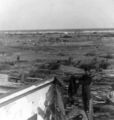
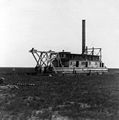
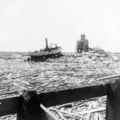

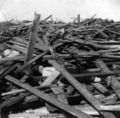

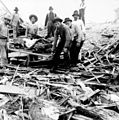






!["After the Disaster" {#586}[41]](http://upload.wikimedia.org/wikipedia/commons/thumb/8/8f/Wea00586.jpg/120px-Wea00586.jpg)

